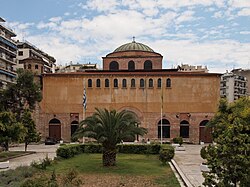This article needs additional citations for verification .(January 2023) |
The Baptistery of St. John the Baptist of Thessaloniki , considered as the oldest early Christian baptistery and assigned to the building complex of a five-aisled episcopal basilica of the fifth century. [1]
The baptistery was identified at the excavations of the Byzantine church of Hagia Sophia. It consists of a room with platforms and includes a font. It was in direct contact with the royal in the 5th century from the hallway with a mosaic floor.
